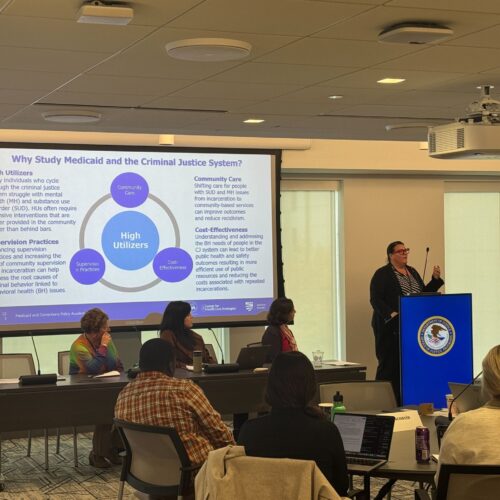Strengthening and Maintaining Family Connections: Best Practices for Child-Friendly Video Visiting
Strengthening and Maintaining Family Connections: Best Practices for Child-Friendly Video Visiting
Visiting is an essential way for families to maintain and strengthen relationships during a family member’s incarceration, particularly for children with incarcerated parents. This brief shares 12 best practices for supplementing in-person visiting with video visiting options. Photo credit: Photo by Alexander Dummer on Unsplash
Strengthening and Maintaining Family Connections: Best Practices for Child-Friendly Video Visiting
Visiting is an essential way for families to maintain and strengthen relationships during a family member’s incarceration, particularly for children with incarcerated parents. Visiting meets different needs for different parts of the family unit:
■ For children, visiting is an opportunity to see, talk with, and play with their incarcerated parent. In keeping with the Children of Incarcerated Parents Bill of Rights, which states, “I have the right to speak with, see and touch my parent,”1 visiting can help children cope with their parent’s incarceration and potentially minimize its negative impact on behavioral and mental health outcomes.2
■ For incarcerated parents, visiting helps promote their parental identity, contributes to maintaining parent-child connections, and can ultimately positively impact mental health, behavior, family reunification, community reintegration, and long-term recidivism reduction.3
■ For the family and caregivers, visiting promotes a type of connection that better prepares the incarcerated parent and families for reunification than phone calls and letters do. While phone calls are time-limited, and letters often involve awaiting a response for extended periods, visiting can more accurately approximate interactions in the community. Visits are real-time opportunities for family members to engage in typical conversation patterns, connect at length, and explore a range of emotions. When family members can solve problems, brainstorm, and resolve conflicts together during a person’s incarceration, they are better prepared to do those things upon reentry.4
In-person visiting is widely considered to be the most effective way for incarcerated parents to maintain and strengthen family relationships or establish new ones.5 In-person visiting can also offer opportunities for families to heal relationships that have been impacted by the trauma of incarceration. However, correctional facilities face some challenges to holding in-person visits, including staffing shortages and conflicting priorities of providing family support while accounting for security measures. For families, in-person visits may involve costs related to long-distance travel, including transportation, childcare, and time off from work. Specific policies that limit in-person contact, such as mandated non-contact visits, pose additional barriers to supporting healthy family connections during parental incarceration. The COVID-19 pandemic has only exacerbated existing challenges that impact capacity for and availability of visits. Video visiting is one way to maintain regular and frequent contact in addition to in-person visiting.
Supplementing in-person visits with video visiting options can mitigate difficulties associated with in-person visiting and offer additional benefits by
■ Limiting long-distance travel;
■ Facilitating consistent communication;
■ Allowing for convenience and flexibility; and
■ Offering incarcerated parents the ability to be a part of their child’s home life.
Video visiting has enabled incarcerated parents across the country to be involved in their children’s lives in meaningful ways that bridge physical separation, such as participating in parent-teacher conferences, attending dance recitals and graduations, choosing outfits for prom and other events, and interacting in children’s everyday play. Adhering to best practices is crucial to ensure that these visits meet the needs of incarcerated parents and families.
12 Best Practices for Video Visiting
There are many policies and practices that are important for correctional facilities to adopt for child-friendly and family-centered video visiting programming.6 The following strategies are informed by research on visiting and maintaining family connections, as well as input from practitioners and administrators through a survey of Second Chance Act Addressing the Needs of Incarcerated Parents and Their Minor Children grantees on their capabilities for visiting and related challenges they experience.
1. Offer video visits as a supplement to in-person visits—not as a replacement. Practitioners and advocates sometimes struggle with how to promote child- and family-friendly video visits without appearing to support the elimination of in-person visits, especially since the benefits of in-person visits are so widely documented. To meet the needs of incarcerated parents and families and be responsive to families’ unique circumstances, facilities should offer both in-person and video visiting options.
2. Provide video visiting options that are free to families.
Correctional agencies can pursue a variety of financing options to ensure that the cost of visiting is not an undue burden on families. Departments of corrections might include the cost of video visits in their operating budgets, partner with a technology platform that covers part or all of the cost without a charge to the family, apply for funding (such as Second Chance Act grants) to support video visiting, engage with a community-based organization that can provide technology and facilitation for free video visits, or some combination of these options.
3. Offer families flexibility in the location of video visits.
Specifically, departments of corrections can give families the option of conducting video visits from their home on a personal device or at a site in their community. Video visiting from home supports comfort, convenience, and flexibility for families, while simultaneously enabling correctional facilities to ensure that the visit is still occurring in a space with pre-approved visitors. Correctional facilities can also partner with a community-based organization or local library to offer video visiting access for families that need additional technical support.
4. Be responsive to children’s and families’ schedules.
Families often request more options for visiting days and times.7 Additional scheduling options can include time on weekends and weekdays with after-school hours, particularly to accommodate families involved in the child welfare system. Balancing the constraints of agencies that operate within a traditional weekday schedule requires intentional coordination that prioritizes both case worker and family needs.
5. Embrace, expand, and support technological capacity for both incarcerated parents and their families.
Inadequate technical support is a major challenge for facilities and families when it comes to video visiting. Some correctional agencies have found success providing wi-fi support and free devices for families. Facilities can also designate a point person on staff to troubleshoot with equipment and video connections during calls.
6. Engage families in activities and play.
Providing incarcerated parents with activities and games to use during video visits gives them an opportunity to help shape the structure of the visit and make sure the child’s needs for play and engagement are met. Facility staff who run parenting groups or other program staff can collaborate with incarcerated parents to design a list of icebreakers and conversation topics. Correctional facilities can also consider giving incarcerated parents and children access to the same books, so families can read along together.
7. Create spaces in the correctional facility that are conducive to parents’ virtual engagement with children.
Add artwork or murals on the walls as the background of video visits to normalize the child’s experience of the visit with their incarcerated parent.
8. Develop humanizing policies for how families are permitted to engage during video visits.
Correctional facility visiting policies sometimes limit behaviors that are typical in family interactions. Policies that relate to video visits should center the experience of shared family time. This includes allowing family members to show photographs during visits and allowing incarcerated parents to wear regular clothing during visits. Policies should also include realistic expectations that allow children to express difficult emotions without the threat of the visit ending.
9. Give families easy access to policies about video visiting.
A tip sheet for the incarcerated parent, family, caregiver, and child that includes the rules of video visiting and guidelines for conversations through video (e.g., who can be present on the video call or any topics that aren’t allowed to be discussed) can mitigate challenges for both families and facilities. Any such guidelines should be clearly posted on the department of corrections’ website and be available in the primary language of the families for ease of access.
10. Provide support before, during, and after visits.
Even when best practices are implemented, all visits, including video visits, can still be stressful. Having support helps when there are tough conversations, child behavioral issues, and emotional reactions during and after the visit. Support during the visit can include visit coaching and facilitated visit activities and play.8 Support after the visit can include access to resources online or conversations with a support person for either incarcerated parents in the facility or children and families in the community. Offering this support might require partnering with an outside community-based organization or mental health staff in the facility.
11. Establish strong feedback mechanisms with incarcerated parents and their families.
Involving incarcerated parents and families in defining needs, identifying challenges, and designing solutions is essential to successful video visiting programming. Families’ input and feedback can help with barriers to implementation, building buy-in, and adopting policies and procedures that best meet the self-identified needs of families.
12. Train correctional staff on all of the above best practices.
Training can be offered on a regular basis for all staff involved in the video visiting process, including corrections officers supervising visits. Training can also include fundamentals of child development, trauma-informed principles, and conflict resolution strategies. When possible, extending training to other correctional staff on units can aid in creating a culture that supports visiting across the facility.
Additional Resources
■ Lindsey Cramer, Margaret Goff, Bryce Peterson, and Heather Sandstrom, Parent-Child Visiting Practices in Prisons and Jails: A Synthesis of Research and Practice (Washington, DC: Urban Institute, 2017), https://www.urban.org/research/publication/parent-child-visiting-practices-prisons-and-jails.
■ Léon Digard, Margaret diZerega, Allon Yaroni, and Joshua Rinaldi, A New Role for Technology? Implementing Video Visitation in Prison (New York: Vera Institute of Justice, 2016), https://www.vera.org/publications/video-visitation-in-prison.
■ Echoes of Incarceration, “Visiting – Through the Youth Lens,” December 2, 2014, YouTube video, https://www.youtube.com/watch?feature=emb_title&v=B4VZRs3E1N0.
■ For children: Shannon Ellis, Almost Like Visiting (CreateSpace Independent Publishing Platform, 2016).
■ Allison Hollihan and Michelle Portlock, Video Visiting in Corrections: Benefits, Limitations, and Implementation Considerations (Washington, DC: National Institute of Corrections, 2014), https://s3.amazonaws.com/static.nicic.gov/Library/029609.pdf.
■ Bryce Peterson, Jocelyn Fontaine, Lindsey Cramer, Arielle Reisman, Hilary Cuthrell, Evelyn F. McCoy, Margaret Goff, and Travis Reginal, Model Practices for Parents in Prisons and Jails (Washington, DC: Urban Institute, 2019), https://www.urban.org/research/publication/model-practices-parents-prisons-and-jails.
Notes
1 The Children of Incarcerated Parents Bill of Rights was developed by the San Francisco Children of Incarcerated Parents Partnership (SFCIPP) and revised in 2005. While SFCIPP is no longer operating, the Bill of Rights continues to guide policy and practice with incarcerated parents and their families in jurisdictions across the country.
2 Rebecca Shlafer and Julie Poehlmann, “Attachment and Caregiving Relationships in Families Affected by Parental Incarceration,” Attachment and Human Development 12, no. 4 (2010): 395–415, https://doi.org/10.1080/14616730903417052; Marty Beyer, Randi Blumenthal-Guigui, and Tanya Krupat, “Strengthening Parent-Child Relationships: Visit Coaching with Children and Their Incarcerated Parents,” in Children of Incarcerated Parents: Developmental and Clinical Issues, ed. Yvette R. Harris et al. (New York: Springer, 2010), 187–214.; Ashton D. Trice and JoAnne Brewster, “The Effects of Maternal Incarceration on Adolescent Children,” Journal of Police and Criminal Psychology 19, no. 1 (2004): 27–35.
3 Joyce A. Arditti, Parental Incarceration and the Family: Psychological and Social Effects of www.mn.gov/doc/assets/11-11MNPrisonVisitationStudy_tcm1089-272781.pdf.
4 Sylvia A. Harvey, The Shadow System: Mass Incarceration and the American Family (New York: Bold Type Books, 2020); Tasseli McKay, Megan Comfort, Christine Lindquist, and Anupa Bir, Holding On: Family and Fatherhood during Incarceration and Reentry (Oakland: University of California Press, 2019); Minnesota Department of Corrections, The Effects of Prison Visitation on Offender Recidivism (St. Paul: Minnesota Department of Corrections, 2011), www.mn.gov/doc/assets/11-11MNPrisonVisitationStudy_tcm1089-272781.pdf.
5 Lindsey Cramer, Margaret Goff, Bryce Peterson, and Heather Sandstrom, Parent-Child Visiting Practices in Prisons and Jails: A Synthesis of Research and Practice (Washington, DC: Urban Institute, 2017), https://www.urban.org/research/publication/parent-child-visiting-practices-prisons-and-jails.
6 Jane A. Siegel and Laura Napolitano, “Adult and Child Visiting at Urban Jails: Perspectives on Visitation Experiences and Policies among Visitors and People in Jail,” The Prison Journal 101, no. 3 (2021): 331–351; Katie Kramer and Carol F. Burton, “What Little We Know: A System-Wide Descriptive Study on Children of Incarcerated Parents in Two U.S. Jurisdictions,” in Contemporary Research and Analysis on the Children of Prisoners: Invisible Children, ed. Liz Gordon (Newcastle upon Tyne: Cambridge Scholars Publishing, 2018), 209–225.
7 Ibid.
8 Marty Beyer, “Visit Coaching: Building on Family Strengths to Meet Children’s Needs,” Juvenile and Family Court Journal 59, no. 1 (2008): 47–60, https://doi.org/10.1111/j.1755-6988.2007.00004.x.
Project Credits
Writing: Megan Pfeiffer and Valerie Carpico, CSG Justice Center; Ann Adalist-Estrin, National Resource Center on Children and Families of the Incarcerated
Research: Megan Pfeiffer and Valerie Carpico, CSG Justice Center; Ann Adalist-Estrin, National Resource Center on Children and Families of the Incarcerated
Advising: Stephanie Joson, CSG Justice Center
Editing: Katy Albis, CSG Justice Center
Design: Justin Crawford, CSG Justice Center
Public Affairs: Sarah Kelley, CSG Justice Center
Web Development: Catherine Allary, CSG Justice Center

This project was supported by Grant No. 2020-CZBX-K001 awarded by the Bureau of Justice Assistance. The Bureau of Justice Assistance is a component of the Department of Justice’s Office of Justice Programs, which also includes the Bureau of Justice Statistics, the National Institute of Justice, the Office of Juvenile Justice and Delinquency Prevention, the Office for Victims of Crime, and the SMART Office. Points of view or opinions in this document are those of the author and do not necessarily represent the official position or policies of the U.S. Department of Justice.
About the author



When returning to their communities from criminal justice settings, people with behavioral health needs face barriers in accessing…
Read MoreNew Hampshire Department of Corrections Commissioner Helen Hanks presents at the Medicaid and Corrections Policy Academy in-person meeting.
Read MoreThe Council of State Governments (CSG) Justice Center has launched the Collaborating for Youth and Public Safety Initiative…
Read More Assigned to the Cloud Crew: The National Incarceration Association’s Hybrid Case Management for People with Behavioral Health Needs
Assigned to the Cloud Crew: The National Incarceration Association’s Hybrid Case Management for People with Behavioral Health Needs
When returning to their communities from criminal justice settings, people with behavioral…
Read More Meet the Medicaid and Corrections Policy Academy Mentor States
Meet the Medicaid and Corrections Policy Academy Mentor States
New Hampshire Department of Corrections Commissioner Helen Hanks presents at the Medicaid…
Read More Six States Commit to Improving Statewide Strategies to Address Youth Crime, Violence and Behavioral Health
Six States Commit to Improving Statewide Strategies to Address Youth Crime, Violence and Behavioral Health
The Council of State Governments (CSG) Justice Center has launched the Collaborating…
Read More Bipartisan Group of 88 Lawmakers Push for Continued Funding for Reentry and Recidivism Programs
Bipartisan Group of 88 Lawmakers Push for Continued Funding for Reentry and Recidivism Programs
A bipartisan group of 88 lawmakers, led by Representatives Carol Miller (R-WV)…
Read More










